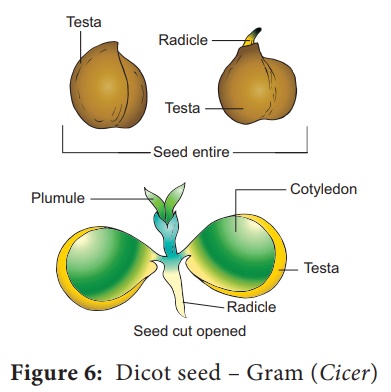Fresh or Preserved Specimens - Botany Practicals - Dicot seed | 12th Botany : Practicals
Chapter: 12th Botany : Practicals
Dicot seed
Fresh or preserved specimens
Exercise: Dicot seed
Aim: To study and identify
the Dicot seed
Principle: The fertilized ovule is
called seed and possesses an embryo, endosperm and a protective coat.
Seeds may be endospermous or non endospermous.
Requirements: Chick pea, bowl, water
Soak
the seeds of chick pea or gram in water for 2 – 3 hours. Drain the water and
place the seeds in a moist cotton cloth for 2 – 3 days. Observe for
germination. Select some sprouted seeds, observe under a dissection microscope
and record the parts.

Diagnostic Features
·
Seeds of gram have two cotyledons and an embryonal axis.
·
Each seed is covered by two seed coats (a) Testa – outer coat and
(b) Tegmen – inner coat.
·
The embryonal axis consists of radicle and plumule.
·
The portion of the embryonal axis above the level of cotyledons is
called epicotyl. It terminates into the plumule.
·
The portion of the embryonal axis below the level of cotyledons is
called hypocotyl. It terminates into the radicle or root tip.
Related Topics